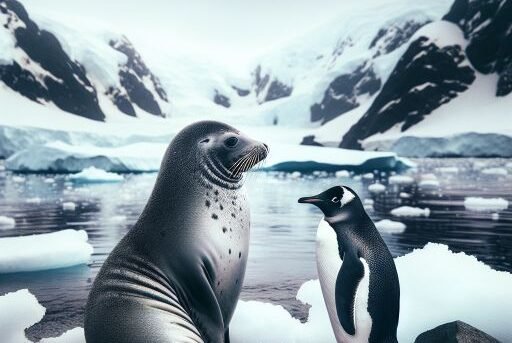Location and Habitat
Seals and penguins are iconic residents of the Antarctic, each adapted to thrive in its harsh conditions. Seals are often found sprawled on the ice floes or swimming in the frigid waters of the Antarctic and sub-Antarctic regions. They utilize the ice as a platform for resting, molting, and breeding. Various species, including the Weddell seal and the leopard seal, are particularly well-adapted to the cold with their thick blubber and streamlined bodies.
Penguins, on the other hand, are synonymous with Antarctic life. Species like the Emperor Penguin and the Adélie Penguin breed and live on the Antarctic continent and its surrounding islands. Emperor Penguins are especially remarkable for their breeding behavior, enduring the brutal winter to incubate their eggs. These flightless birds are superbly adapted to the aquatic life, spending a significant amount of time in the ocean hunting for fish, krill, and squid. Their compact bodies and strong flippers make them excellent swimmers, adept at navigating the icy waters of their southern habitat.
Seal vs. Penguin Comparison
| Animal | Size and Weight | Ability to Finish Opponent | Weaponry |
|---|---|---|---|
| Seal | Varies by species, up to 880 lbs (400 kg) and 10 ft (3 m) long | High; strong and agile in water, can overpower penguins easily | Sharp teeth, strong jaws |
| Penguin | Varies by species, up to 88 lbs (40 kg) and 3.7 ft (1.1 m) tall | Low; primarily defensive, lacks offensive capabilities against seals | Beak, flippers (mostly for swimming and defense) |
Hunting and Skills
Seals in the Antarctic, such as the leopard seal, are formidable predators that primarily hunt penguins, fish, and squid. They are adept at ambushing their prey, using their powerful jaws and sharp teeth to capture and kill. Leopard seals, in particular, are known for their aggressive hunting technique where they grab penguins by their feet, shaking them violently to remove the skin before consuming them. On the other hand, penguins, such as the Emperor penguin, primarily feed on fish, krill, and squid, diving deep into the water to catch their food. While penguins are prey for seals, they rely on their agility in water, swimming in groups, and their camouflaged plumage to evade predators. In confrontations, penguins can often escape by outmaneuvering seals in the water, using icebergs and tight spaces to their advantage.
Seal vs. Penguin (Antarctic encounter) Who Would Win?
The seal chases the penguin on ice. The penguin attempts to escape by sliding into the water. In water, the seal has superior agility and speed. The seal catches the penguin, overpowering it with strength. Seal wins with an 85% chance of victory.
Important Points to consider
Here are some important points to consider for seal vs. penguin fight:
Habitat:
- Seals: Primarily aquatic mammals, spending most of their time in the water. They come to land for breeding and basking.
- Penguins: Flightless birds that live on land (often icy coasts) but spend a significant amount of time swimming in the ocean to hunt.
Predation:
- Seals: Apex predators in the water, hunting fish, squid, and even penguins.
- Penguins: Prey for seals in the water. On land, they can be vulnerable to birds and land mammals.
Body type:
- Seals: Streamlined bodies with flippers for propulsion in water. Can move awkwardly on land.
- Penguins: Streamlined bodies with flippers for swimming. Upright posture and short legs make them clumsy on land but excellent swimmers.
Defense:
- Seals: Sharp teeth and claws for catching prey but also for defense. They can be quite aggressive.
- Penguins: Limited defense on land. They rely on camouflage and agility in the water to avoid predators.
Overall:
- In the water: Seals are the clear winner. Their bodies are built for swimming and hunting, and penguins are their natural prey.
- On land: The advantage depends on the situation. Penguins can be faster and more maneuverable on land, but seals can still be dangerous with their size and strength.
Additional factors:
- Species: Different seal and penguin species vary in size and hunting prowess.
- Size and age: A large, healthy seal will overpower a small penguin, but a young or injured seal might be vulnerable.
- Group behavior: Both seals and some penguin species can form large groups, which can deter attacks or help defend against predators.




